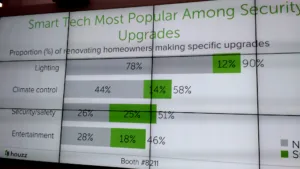The home-focused web site Houzz teamed up with CEDIA to conduct a survey of nearly 1,000 homeowners in the midst of planning, or who have recently completed, a home renovation project. According to the 2016 U.S. Houzz Smart Home Trends Survey, nearly half of renovating homeowners are incorporating “smart” technology: systems or devices that can be monitored or controlled via smartphone, tablet or computer (45%).
Renovated homes are more than twice as likely to include a smart system or device than before the renovation (51% versus 20%, respectively). On the other hand, 49% did not make any smart home upgrade as part of the renovation.
The top two challenges renovating homeowners face when it comes to incorporating smart home features are educating themselves about available options and finding the right products/technology. This is consistent for security/safety, lighting, climate control and entertainment features. Over half of renovating homeowners opted against adding smart technologies during their renovation projects (55%). Among those non-adopters, only a third gave the technologies some consideration (34%), but ultimately decided not to go the smart tech route due to a lack of interest (37%), cost concerns (31%), or privacy concerns (23%).
Spending on smart systems and devices differs depending on the technology type. The majority of smart home security/safety upgraders spend less than $1,500 or less on their new/updated features (76%), while only 5% invest more than $5,000. There is greater variability in the cost of smart entertainment upgrades, with half spending $1,500 or less (48%), and another half investing more than $1,500 (52%). One-fifth of entertainment upgraders spend more than $5,000 on their new technology (21%). Similarly, nearly half of smart lighting upgraders spend $1,500 or less (47%), while just over half spend more than $1,500 (53%).
In terms of smart climate control technology, homeowners rarely spend within the $1,501-$2,500 range. Instead, half of renovating homeowners report spending under $1,501, and another half spend more than $2,500 (50% and 46%, respectively). Similar to entertainment upgraders, a fifth of renovating homeowners updating climate control systems invest more than $5,000 in their new features (21%).
The survey provided quite a lot of statistical information about smart home product purchases, as summarized below. For example, nearly a third of upgraded smart home systems or devices can be controlled via a central hub (30%), and a quarter include voice-controlled features (26%). Homeowners report greater levels of satisfaction with their upgraded smart features than their non-smart features.
The survey also looked at what smart home features were popular for the installations. Homeowners are installing smart devices for security/safety (25%), entertainment (18%), climate control (14%) and lighting (12%) in their renovated homes.
The top smart security/safety devices include fire and gas alarms and cameras (in 9% of renovated homes, each), followed by motion, glass breakage and/or door sensors, door locks and/or video doorbells (5% each). Protecting their homes against intruders (67%), and monitoring/controlling the safety of their home when they are away (52%) or from anywhere in the home (30%) are of primary concern. Protection against intruders is a stronger motivation for those installing smart security/safety features than those installing non-smart options (67% versus 51%, respectively).
Around 12% of renovated homes include a smart thermostat – 40% of upgraded thermostats or temperature controls are smart. Smart climate control features are selected to improve the comfort of the household (71%), reduce energy consumption (68%) and to monitor or control their device while away from home (41%).
When it comes to lighting, 11% of renovated homes include smart indoor lighting, and 4% include smart outdoor lighting. Homeowners are motivated to include smart tech to reduce energy consumption (59%), improve the comfort of the household (54%) and have the ability to change the mood or vibe of the home (34%).
Only 8% of upgraded homes feature a smart TV, and 7% include smart speakers or video/music streaming devices. This low result was interpreted to mean that smart features are already in these devices. – CC

